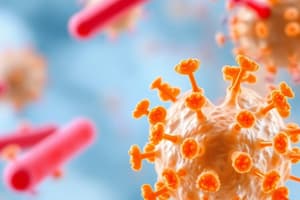Podcast
Questions and Answers
What initiates B cell activation?
What initiates B cell activation?
- Direct interaction with pathogens
- Recombination of DNA
- Release of cytokines
- Binding to a specific antigen (correct)
Which process contributes to antibody diversity through DNA rearrangements?
Which process contributes to antibody diversity through DNA rearrangements?
- Apoptosis
- Alternative splicing
- Recombination (correct)
- Somatic hypermutation
What role does Activation-induced cytidine deaminase (AID) play in B cells?
What role does Activation-induced cytidine deaminase (AID) play in B cells?
- Induces somatic hypermutation (correct)
- Facilitates antigen binding
- Enhances polyclonal expansion
- Triggers apoptosis
Where does the diversification of activated B cells primarily occur?
Where does the diversification of activated B cells primarily occur?
What characterizes monoclonal antibodies?
What characterizes monoclonal antibodies?
How do antibodies primarily aid in pathogen elimination?
How do antibodies primarily aid in pathogen elimination?
What is the main advantage of using phage display in antibody engineering?
What is the main advantage of using phage display in antibody engineering?
What is a characteristic feature of polyclonal antibodies?
What is a characteristic feature of polyclonal antibodies?
What are the two types of light chains found in antibodies?
What are the two types of light chains found in antibodies?
What structural feature confers specificity in the binding of antibodies to antigens?
What structural feature confers specificity in the binding of antibodies to antigens?
Which part of the antibody is designated as the 'Fc' region?
Which part of the antibody is designated as the 'Fc' region?
How do antibodies differ in terms of their heavy chains?
How do antibodies differ in terms of their heavy chains?
What is a key feature of the antibody structure known as 'Fab'?
What is a key feature of the antibody structure known as 'Fab'?
Why are antibodies considered 'big business'?
Why are antibodies considered 'big business'?
Which statement about the immunoglobulin fold is true?
Which statement about the immunoglobulin fold is true?
What can antibodies bind to apart from large antigens?
What can antibodies bind to apart from large antigens?
What is the primary function of ATP hydrolysis in muscle contraction?
What is the primary function of ATP hydrolysis in muscle contraction?
Which of the following best describes the structure of G-actin?
Which of the following best describes the structure of G-actin?
What initiates the contraction of a muscle cell?
What initiates the contraction of a muscle cell?
How do thick and thin filaments differ in muscle fibers?
How do thick and thin filaments differ in muscle fibers?
Which component is essential for the binding of myosin to actin?
Which component is essential for the binding of myosin to actin?
What structural feature allows the myosin tail to form aggregates?
What structural feature allows the myosin tail to form aggregates?
What is the role of the troponin complex in muscle contraction?
What is the role of the troponin complex in muscle contraction?
What does the Walk-Along mechanism describe in muscle contraction?
What does the Walk-Along mechanism describe in muscle contraction?
Flashcards are hidden until you start studying
Study Notes
Antibodies
- Antibodies are Y-shaped proteins that bind to specific antigens.
- The Y shape has two arms called Fab regions, which bind to antigen.
- The base of the Y is called the Fc region, which binds to immune cells.
- The variable regions (VH and VL) of the Fab region determine the antibody's specificity for its antigen.
- Antibodies can bind many different kinds of antigens, including proteins, small molecules, and cells.
- Antibodies are used in many medical applications, such as diagnosing diseases, treating tumors, and preventing infections.
Antibody Diversity
- Antibody diversity is achieved through two steps:
- Recombination: DNA segments for variable regions are randomly rearranged.
- Somatic hypermutation: Point mutations are introduced into the variable regions, fine-tuning antibody affinity.
B-Cell Activation
- B-Cells are responsible for producing antibodies.
- B-cells are activated by binding antigen and interacting with T-cells.
- Activated B-cells undergo differentiation into plasma B cells, which produce antibodies.
- Activated B-cells diversify in the spleen.
How Antibodies Help
- Antibodies help fight infection by:
- Neutralizing pathogens: Directly blocking the pathogen from entering cells.
- Precipitating antigens: Forming complexes that can be phagocytosed by immune cells.
- Activating complement: A cascade of proteins that leads to the lysis of the pathogen.
- Promoting phagocytosis: Making it easier for immune cells to eat the pathogen.
Monoclonal Antibodies
- Monoclonal antibodies are produced by a single B-cell clone.
- Monoclonal antibodies are highly specific for a particular antigen.
- Monoclonal antibodies are used in a wide range of applications, including treating cancer, diagnosing diseases, and researching new antibodies.
Myosin
- Myosin is a motor protein that enables muscle contraction.
- Myosin consists of a long filamentous tail and a globular head.
- The head of myosin binds to actin and hydrolyzes ATP, generating a force that moves the actin filament.
- The muscle contraction process requires ATP hydrolysis, which provides energy for the movement.
Muscle Contraction
- The myosin head binds to actin, forming a crossbridge.
- ATP is hydrolyzed, causing the myosin head to swivel and move the actin filament.
- This process of "walking" on the actin filament is called the "walk-along mechanism."
- Contraction is triggered by calcium influx into muscle cells.
Other Components of Myofibrils
- Troponin Complex & Tropomyosin:
- Tropomyosin binds to actin, blocking myosin binding sites.
- Troponin complex binds to both tropomyosin and calcium -- Calcium binding to troponin moves tropomyosin, exposing myosin binding sites on actin.
Studying That Suits You
Use AI to generate personalized quizzes and flashcards to suit your learning preferences.


